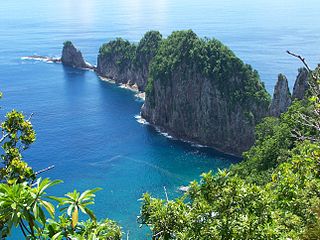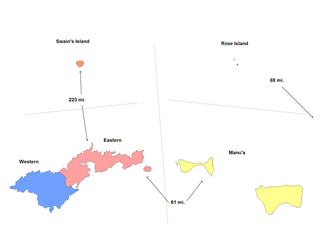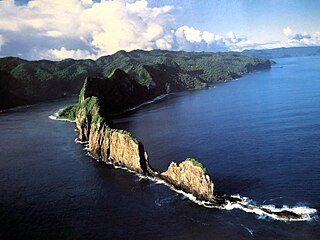
The National Park of American Samoa is a national park in the United States territory of American Samoa, distributed across three islands: Tutuila, Ofu, and Ta‘ū. The park preserves and protects coral reefs, tropical rainforests, fruit bats, and the Samoan culture. Popular activities include hiking and snorkeling. Of the park's 13,500 acres (5,500 ha), 9,000 acres (3,600 ha) is land and 4,500 acres (1,800 ha) is coral reefs and ocean. The park is the only American National Park Service system unit south of the equator.

Tutuila is the largest and the main island of American Samoa in the archipelago of Samoan Islands. It is the third largest island in the Samoan Islands chain of the Central Pacific located roughly 4,000 kilometers (2,500 mi) north-east of Brisbane, Australia and over 1,200 kilometers (750 mi) northeast of Fiji. It contains a large, natural harbor, Pago Pago Harbor, where Pago Pago, the capital of American Samoa, is situated. Pago Pago International Airport is also located on Tutuila. Its land expanse is about 68% of the total land area of American Samoa and with 56,000 people accounts for 95% of its population. The island has six terrestrial and three marine ecosystems.

This is a list of the buildings, sites, districts, and objects listed on the National Register of Historic Places in American Samoa. There are currently 31 listed sites spread across the three districts of American Samoa. There are no sites listed on the unorganized atoll of Swains Island.

Utulei is a village in Maoputasi County in the Eastern District of Tutuila, the main island of American Samoa. Utulei is the legislative capital of American Samoa, and is located east of Pago Pago. It is home to most hotels and most historic buildings in Pago Pago. The Executive Office Building is located here, just next to Feleti Barstow Library and paved roads that wind up to the former cablecar terminal on Solo Hill. Lee Auditorium, which was built in 1962, is also located in Utulei. American Samoa's television studios, known as Michael J. Kirwan Educational Television Center, and the Rainmaker Hotel, are also found in Utulei. Utulei Terminal offers views of Rainmaker Mountain.

Vai'ava Strait is the name of a narrow strait located in Vatia, American Samoa. It is a 250 acres (100 ha) National Natural Landmark. The strait is a great example of cliffs formed by waves on volcanic rock. The strait consists of communal lands. It was designated as a U.S. National Natural Landmark in 1972. Vai'ava Strait separates the 420 feet (130 m) high Pola Tai Island from Polauta Ridge. Pola-Uta is connected to the village of Vatia on Tutuila Island. Pola Tai is a 400 feet (120 m) cliff that is an important nesting area for the fua'ō and tava'e. Hunting of brown boobies, known as the A'ega o le Pola, was a tradition carried out by Vatians in the past. Pola Tai includes Matalia Point, Cockscomb Point and Polauta Ridge.

Government House, also known as Building No.1, Naval Station, Tutuila or Government House, U.S. Naval Station Tutuila, is a historic government building on the grounds of the former Naval Station Tutuila in Pago Pago, American Samoa. Built in 1903, it has served as a center of government on the island for much of the time since then. Government House was listed on the United States National Register of Historic Places in 1972, and was declared a National Historic Landmark in 1990.

The Blunts Point Battery, also known as Blunts Point Naval Gun or Matautu Ridge Gun Site, is a gun battery on Matautu Ridge near Pago Pago, American Samoa. It was part of the fortification of the Samoan Islands which took place after the attack on Pearl Harbor, and is a rare example of a World War II Pacific coastal gun which remains in relatively pristine condition. It was declared a National Historic Landmark in 1987.

Afao is a village in southwest Tutuila Island, American Samoa. It is located on the island's short southwestern coast, between 'Amanave and Leone, to the southwest of Pago Pago. It includes the settlement of Atauloma. Afao is home to two places listed on the U.S. National Register of Historic Places: Afao Beach Site and Atauloma Girls School.

Āfono is a village on the northeast coast of Tutuila Island, American Samoa. One of the island's more populous villages, it is located on the edge of Afono Bay, at the eastern edge of the National Park of American Samoa. It is connected by Highway 6 to Vatia, which lies along the coast to the northwest, and to Aua, on the edge of Pago Pago Harbor to the south via a winding stretch of highway which crosses the spine of the island.
The A'a Village Site, designated "AS-34-33" by archaeologists, is an abandoned village site on the island of Tutuila in American Samoa. Located on a bay on the northwest coast of the island, the site was first surveyed by professional archaeologists in 1985. The site has four distinct areas, in which features interpreted as house foundations have been located, as have rock walls, grave sites, and platform mounds. The site was not known to be occupied within the living memory of nearby residents, and the size of trees in the site suggests it has been abandoned since the 1860s.
The Lau'agae Ridge Quarry is a prehistoric stone quarry on the eastern side of the island of Tutuila in the United States territory of American Samoa. It is located on a ridge above another archaeological site, the prehistoric village of Tulauta. The site includes a carpet of stone flakes, evidence of rough stonework, signs of habitation, and two tia'ave, oval stone platforms found in abundance on the island.
The Maloata Village Site is a prehistoric village site on the northwestern coast of the island of Tutuila in the United States territory of American Samoa. The archaeologically sensitive site includes a variety of stone features, principally stone fences and retaining walls, with evidence from excavation of human habitation. Radiocarbon dating from one of its test pits yielded a date range of CE 550–1000, identifying the site as one of the oldest known on the island. According to oral tradition, the Maloata area was reserved for use by relatively high-status chieftains.
The Faga Village Site is a major archaeological site in the United States territory of American Samoa. Located on the north shore of the island of Ta'u, it is, according to local oral history, one of the oldest settlements in all of the Samoan islands, and an important site in the formation of Samoan culture. The site includes a large number of house foundations, terraces, stone walls, and other stone-built features. Excavations at the site have yielded radiocarbon dates indicating the site was occupied as far back as 1000 CE. The site continues to be of cultural importance to the local Samoan population.
The Tulauta Village Site is a prehistoric village site in far eastern Tutuila, the largest island of American Samoa. The site includes 10-13 house sites, a number of grave site, and other features, including stone enclosures interpreted as pig sties, fire pits, and walls. An upright basalt slab was found, which may have been of local religious significance. Early archaeological testing took place here in the 1970s, with more extensive examinations in the 1980s and 1990s. A large number of basalt stone flakes led an early researcher to speculate that it was a quarry site; it is more likely the inhabitants were working stone quarried from a site on the ridge above.
The Tataga-Matau Fortified Quarry Complex, designated Site AS-34-10, is a major archaeological complex on Tutuila, the largest island of American Samoa. Located in an upland area on the western side of the island above the village of Leone, the complex consists of a series of basalt quarries and structures that archaeologists have interpreted as having a military defensive purpose. The site has been known since at least 1927, and was first formally surveyed in the 1960s. Features of the site include extraction pits, from which basalt was quarried for the manufacture of stone tools and weapons, as well as domestic features such as grinding stones. Archaeologists in 1985 noted that some of the sites features were, including trenches and terracing, were made in areas that were unsuitable for the production of stone tools, and closely resemble known military defensive structures in other areas of the Samoan islands. The site extends along a network of ridges for more than 1.4 kilometres (0.87 mi). Radiocarbon dating of elements of site indicate periods of occupation and/or use from c. 200 CE to the period of European contact.

Vatia is a village on Tutuila Island in American Samoa. It is a north shore village located on Vatia Bay. The road to Vatia, American Samoa Highway 006, is the only road going through National Park of American Samoa. Vatia is a scenic community at the foot of Pola Ridge and surrounded by the national park. It is only reached by Route 6 which traverses the national park before reaching Vatia. There was once a hiking trail over Maugaloa Ridge from Leloaloa, but since the completion of Route 6, this trail is now overgrown. It is home to a beach, and panoramic views of jungle-covered peaks surround the village on all sides. Vatia is the center of the Tutuila-section of National Park of American Samoa. It is located in Vaifanua County.

Fagasā is a village in the Eastern District of Tutuila Island in American Samoa. The village lies by Fagasa Bay, on the north shore of the island. Its name is Samoan and translates to “Forbidden Bay.” The village borders the Tutuila-section of National Park of American Samoa. The trailhead to Mount ‘Alava is located near the village by Fagasa Pass.
Amalau is the name of a valley and a bay within the National Park of American Samoa. Amalau Valley is located between Vatia and Afono, and it is an isolated valley with various wildlife such as large numbers of native bird species and flying fox megabats. Amalau Valley is reached on the road leading to Vatia. There are only a few homes at Amalau.

Pola Island is an island off the shores of Vatia on Tutuila Island in American Samoa. It is also known as Cockscomb. Pola Island is one of the most popular attractions in National Park of American Samoa. It is located on the west side of Vatia Bay and has become a landmark and an icon for Vatia. Pola Island has been named one of American Samoa's Seven National Wonders by the Pago Pages. It has been named "the most beautiful natural feature of Tutuila Island” by travel guide publisher Lonely Planet.










